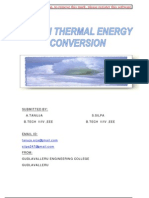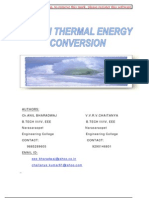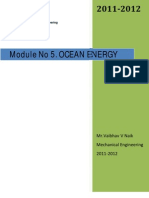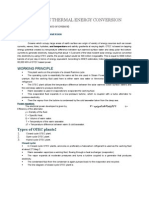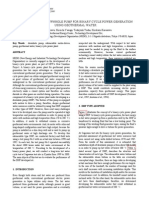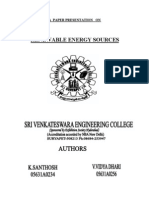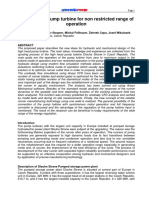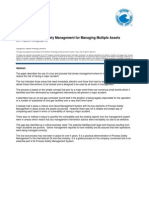Otc 20340
Otc 20340
Uploaded by
Rasheed YusufCopyright:
Available Formats
Otc 20340
Otc 20340
Uploaded by
Rasheed YusufCopyright
Available Formats
Share this document
Did you find this document useful?
Is this content inappropriate?
Copyright:
Available Formats
Otc 20340
Otc 20340
Uploaded by
Rasheed YusufCopyright:
Available Formats
OTC 20340
Study on the Cost Effective Ocean Thermal Energy Conversion Power Plant
Nagan Srinivasan, Specialist; Meena Sridhar, Deepwater Structures Inc., Houston, Texas, and
Madhusuden Agrawal, ANSYS Inc., Houston, Texas
Copyright 2010, Offshore Technology Conference
This paper was prepared for presentation at the 2010 Offshore Technology Conference held in Houston, Texas, USA, 36 May 2010.
This paper was selected for presentation by an OTC program committee following review of information contained in an abstract submitted by the author(s). Contents of the paper have not been
reviewed by the Offshore Technology Conference and are subject to correction by the author(s). The material does not necessarily reflect any position of the Offshore Technology Conference, its
officers, or members. Electronic reproduction, distribution, or storage of any part of this paper without the written consent of the Offshore Technology Conference is prohibited. Permission to
reproduce in print is restricted to an abstract of not more than 300 words; illustrations may not be copied. The abstract must contain conspicuous acknowledgment of OTC copyright.
Abstract
Ocean Thermal Energy Conversion (OTEC) is a promising renewable energy resource from the ocean near equator that had
been neglected for decades due to its enormous capital cost. The technologies that are developed for oil and gas industry for
deep water applications could be adopted into OTEC power plant and the capital cost could be reduced by fifty percent than
the estimation using conventional OTEC technology. This paper addresses a new OTEC technology for the OTEC power
plant. Design and workability of the individual components of the new OTEC engine is shown. The global architecture of the
power plant is illustrated. The engineering analyses studied show that the new OTEC power plant is feasible to construct and
the cost analysis studied shows that the new OTEC power plant is viable for applications.
Introduction
Clean renewable energy is a necessity of today that more and more people are aware of. Countries all over the world support
this effort, considering that there is no carbon dioxide emission and no environmental impact. Ocean Thermal Energy
Conversion (OTEC), as one of the renewable energy source, is very attractive because no fossil fuel needed and is available
with unlimited large quantity. USA is now spending several billion dollars for various renewable energy source projects. The
operating cost of most of the renewable energy is very low but the capital cost is enormous. Because of the environmental
nature, OTEC is very stable and reliable energy resource for tropical islands like Hawaii. The main challenge is to make the
OTEC electric power generation cost-effective and comparable to the nuclear energy source.
OTEC
OTEC is a method for generating electricity utilizing the source of stored solar energy available in the ocean near the equator,
where the surface water temperature is about 25 degree C or more due to heat from sunlight and at 3000 ft depth the water
temperature is about 4 degree C. A thermodynamic heat transfer method is used to convert the thermal energy to run the gas
turbine. Ammonia gas is used as working fluid for the OTEC engine. Heat transfer is the major engineering task to be
involved on the success of any efficient OTEC power plant. Conventional OTEC does the heat transfer effort on the top of
the platform deck. The amount of water needed to cool the working fluid, ammonia, is enormous. There is a cold water pipe
in the conventional OTEC that is used to bring the cold water from 3000 ft down to the free surface. Similarly the gas heating
process, where the surface warm water is used in the evaporator, faces the similar problem. Enormous amount of heavy
equipment for handling large volumes of water on the surface of floating vessel has increased the vessel size and
consequently the capital cost was very high in the conventional OTEC. This technology is addressed in Reference 1.
New OTEC
This paper addresses an OTEC engine that uses new technologies like sub-sea condenser, sub-sea pump, submerged
evaporator and independent floating-pipe buoy platform to transport working fluid from turbine outlet to the subsea
condenser. Oil and gas field has offered innovative and cost effective solutions for deepwater applications. The technologies
developed for deepwater are well proven and are working in water depth over 6,000 ft. OTEC water depth is only 1,500 ft,
which is much smaller than the depth capabilities of today oil and gas field operations. The new OTEC design uses subsea
solutions for the heat conduction problem. The condenser is located subsea area where the enormous cold water is available
without the need of storage. The condenser is directly exposed to the underwater environment with 4 degree C. The
condenser is designed for 1,500 psi water depth pressure for its structural strength integrity. Subsea condenser is tested for
flow simulation and heat conduction problem for workability by using modern ANSYS Computational Flow Dynamic (CFD)
engineering software. The equipments and the piping are tested for 1,500 psi water pressure to work at 3,000 ft depth.
OTC 20340
An innovative subsea pump is also designed for the new OTEC. A supporting vessel is designed such that the evaporator
could be placed submerged in the telescopic keel-tank. The keel-tank is a part of the supporting vessel thus it does not cost
extra for the support of the submerged evaporator of the new OTEC. The problems resulted with subsea condenser are solved
cost effectively in this paper with different innovative OTEC equipments. The paper aims at coming up with the first 100
mega watt output power plant that could be operated in the State of Hawaii deep water. The new OTEC technology
drastically removed the massive cold water pipe from the conventional OTEC technology and reduces the cost significantly.
This new OTEC technology is explained in Reference 2, emphasizing with various floating support vessel possibilities.
New OTEC-Engine
For the purpose of demonstration, a simplified OTEC cycle is used with the following assumptions. Sea bed is 3000 ft below
sea level; evaporator and expander are located at sea level; condenser and condensed ammonia pump are located at seabed;
turbine operating condition is matched closely to the inlet and outlet conditions of an available General Electric (GE) turbine;
power produced from the turbine is fixed at 20,000 kW. A pipe length equivalent of 3500 ft is used for turbine exhaust and
condensed ammonia is used for pump hydraulic calculations. An 84 ID for turbine exhaust and 24 ID for pump discharge
are used as specified by GE for their turbine specification. However, actual piping design could be made of several smaller
pipelines running in parallel. Those details are studied in the flow simulation problems in another section of this paper. Both
turbine exhaust line and condensed ammonia pump discharge line are also assumed to have heat losses. Both lines outlet and
inlet temperature differences are to be 0.5 oC to approach isothermal. It is assumed that the condensed ammonia pump
discharge control valve has 15 psi pressure drop. The new OTEC cycle is shown in Figure 1 and the Heat balance obtained in
the thermodynamics are show in Table 1. The heat energy balance is obtained as given in Table 2. The turbine inlet and outlet
conditions are obtained for 20 MW power output capacities.
An OTEC engine with subsea condenser located at 3000 ft seabed situation is compared with conventional OTEC, as shown
in Table 3. The power consumption on the condensed ammonia pump is about 33.5% of power generated from the turbine
expander. In order to minimize this power loss, two pumps are used one underwater and a second one above water. The
submerged pump adequately transports the condensed working fluid to the evaporator at the top. Another axial pump is
placed above water to suck the ammonia gas from the evaporator and send that to the turbine for the required input condition.
This method reduces the total power consumption needed for the submerged pump. A new innovative displacement type
pump is designed for this subsea application of the new OTEC power plant. The second pump located above water could be
conventional pump available from standard vendors with large volumetric flow. In order to improve the performance of the
turbine power output, a direct Sun heat chamber is used before the turbine inlet and the new thermodynamic cycle with these
changes is named DeSI-OTEC as shown in Figure 2.
Description
Vapor Fraction
Temperature [F]
Pressure [psig]
Molar Flow [lbmole/hr]
Mass Flow [lb/hr]
Heat Flow [Btu/hr]
101Expander
-Inlet
1
84
128
237,632
4,046,865
- 4,715,261,097
102Expander
- Outlet
0.99
56
85
237,632
4,046,865
- 4,783,561,097
104Condenser
-Outlet
0
39
72
237,632
4,046,865
- 7,011,238,524
108Evaporator
-Outlet
1
84
128
237,632
4,046,865
- 4,715,261,097
106Evaporator
- Inlet
0
43
954
237,632
4,046,865
- 6,988,362,991
Table 1 HEAT AND MATERIAL BALANCE
Description
Heat Flow [MMBtu/hr]
Power (kW)
Q-Expander
68
19,998
Q-Condenser
2,258
661,270
Q-Pump
23
6,698
Q-Evaporator
2,278
667,007
Q-P 100
-46
-13,574
Table 2 ENERGY STREAMS
Inlet Conditions
Mass flow (kg/hr)
Pressure (barG)
Temperature (oC)
Inlet Volume (Am3/hr)
Sub-Sea Condenser OTEC
1,836,000
9.848
29
251,993
Conventional OTEC
1,835,646
9
29
247,626
Discharge Conditions
Pressure (barG)
Temperature (oC)
Adiabatic/Polytrophic Efficiency (%)
Outlet Volume (Am3/hr)
Power generated (kW)
6.874
13.56
83.225 / 82.926
344,503
20,020
6
14.2
84%
338,153
20,000
Table 3 TURBINE INLET AND OUTLET CONDITIONS
Q-P 101
-11
-3,125
OTC 20340
Figure 1: Simplified OTEC Engine with
Subsea Condenser
Figure 2: A New OTEC Engine with
Subsea Condenser
Subsea Pump
A dedicated subsea pump is designed for the new OTEC engine. A 3 dimensional view, a cross section at discharge stroke
and a detail drawing with labels of parts of the subsea pump are shown in Figure 3 (a, b & c) as a group. The subsea pump is
designed innovatively with two chambers, one with large size ammonia tank for transporting the condensed working fluid
from the subsea condenser to the evaporator and another with small size water tank for driving the piston hydraulically. The
ammonia chemical tank is designed larger in size with 4.5 ft diameter bore for more volumetric flow and the water tank is
designed smaller with 2.5 ft diameter bore for smaller volumetric displacement. The piston in the chemical chamber
(ammonia) and the piston in the water chamber are welded at both ends to a hollow cylinder that rides over a circular solid
rod inside. The solid rod is welded on both ends to the two chambers edge walls. The chamber end walls are designed
convex outside to take external water pressure load of 1500 psi. A stronger spring is placed in the chemical side of the
chamber and a weaker spring is placed in the water side of the chamber for operational stability. The piston in the water
chamber is driven by the high pressure water pump placed on top of the platform deck and is connected to the water chamber
by an inlet pipe as shown in Figure 3. The maximum piston stroke distance is 12 inches and equal for both the chambers.
The water is pumped inside the water chamber with fluctuating pressure to drive the subsea pump. When water is supplied
with pressure into the water chamber, it moves the piston from left to right side. Correspondingly the piston on the chemical
side is moved in the same direction. The check valves provided radially on the surface of the larger chamber open-up and the
condensed ammonia is sucked into the discharge side (right side) of the larger chamber. During the suction stroke, the spring
on the larger ammonia chamber is compressed to maximum. When the pressure on the water inlet pipe is reduced to normal,
then the piston is designed to slide back from right to left by the reaction of the larger spring force.
Figure 3 (a & b): Subsea Displacement Pump - shown in Three Different 3D and 2D Views
OTC 20340
Figure 3 (c): Subsea Displacement Pump - shown in Three Different 3D and 2D Views
Several required check valves are used for the operation of appropriate pumping mechanism. The chemical chamber is
designed for 1500 psi external hydraulic pressure at 3000 ft water depth with zero internal pressure. The water chamber is
filled with water such that the internal and the external pressures are equal. A spring loaded check valve is used on the
driving side of the water chamber for applicability. When the internal pressure exceeds the external pressure, then the valve
closes and the piston drives. As the piston in the ammonia chemical chamber moves back and forth, the condensed ammonia
is being sucked from the subsea condenser and moved to the other side with the help of the check valves provided on the
piston surface. The discharge stroke is shown in the 3D cross-section view and the suction stroke is shown in the 2D-detail
drawing. The mass flow of the working fluid from turbine output is 4046885 lb/hr. The gallons per minute (gpm) of the
liquid ammonia fluid required to be pumped up by the subsea pump is 11852.52. The specific gravity of liquid ammonia
multiplied by the gpm volume flow rate and height in feet, divided by 3960 would give the Horsepower required for the
ammonia liquid to be pumped. A minimum of 4.6 MW power is required for the operation of this pump. In order to reduce
the water volumetric flow, inner bore diameter of the water chamber is reduced. The pump could be designed for a rate of 14
strokes per minute with 2200 psi water pressure at the water inlet at the top of the deck. Thus the control of the operation of
the subsea pump is feasible from the deck. The water chamber is designed for 2300 psi additional internal pressure.
Figure 4: Subsea Condenser with Propellers
Figure 5: Independent Vertical Float Buoy
OTC 20340
Subsea Condenser
A dedicated sub sea condenser is designed for the new OTEC engine. The condenser has inlet and outlet tanks. For efficient
condensation of ammonia by cooling, a shell type condenser is used underwater and is shown in the Figure 4. Thin
rectangular tubes are bent and placed between the inlet and the outlet tanks. The rectangular tube is designed with a narrow
gap of 3 inch width. The tube is internally supported with vertical plates to withstand hydrostatic outside water pressure of
1500 psi. The spacing between the tubes bend is designed adequate for the surrounding sea water to flow naturally in
between without resistances. Several electric propellers (Figure 4) are mounted on the other side of the condenser such that a
stream of cold water flow is induced from one side to the other of the condenser through the designed spacing between the
tube bends. These sub sea propellers that will induce the flow are operated hydraulically from the platform deck top through
flexible hoses.
The structural integrity of the subsea condenser is verified for 3000 ft water depth external pressure application. For efficient
heat conduction, aluminum is used as the material for the subsea condenser tubes. The mass flow and the heat conduction
problems are solved with the ANSYS Computational Flow Dynamic (CFD) program. The results of the analysis are
illustrated in the following section of this paper. Similar design concept is applied for the submerged evaporator situated
closer to the free surface. The CFD and the heat conduction studies are carried out for the evaporator.
Simulation of Ammonia Flow and Heat Conduction
This section of the paper presents the results of CFD and heat transfer analyses for the subsea condenser and submerged
evaporator using ammonia as the working fluid and the surrounding sea water as the cooling or heating media fluid. First
CFD modeling was performed to study the flow behavior of the ammonia gas from the turbine to the top of the vertical pipebuoy though smaller size pipes with the use of a manifold at the turbine outlet and at the top of the vertical pipe buoy.
ANSYS FLUENT software was used for this CFD simulation. The results were used to obtain the optimum geometry of the
inlet pipes. Ammonia vapor exits from the turbine through a pipe of 7ft diameter outlet at about 25 m/s. A manifold is
required to split the ammonia flow into several smaller pipes which can be fed into the vertical pipe-buoy [Figure 5] at the
top through a similar size manifold. Another manifold is designed at the bottom of the vertical pipe-buoy to distribute the
ammonia gas into several smaller subsea condensers located on the seabed. The purpose of this second manifold is to reduce
the velocity of the hot gas ammonia which is supplied to the condenser inlet for effective cooling. Both of these manifolds
were modeled and geometries of these manifolds are shown in Figure 6 and in Figure 8.
A diffuser on the turbine side is used which expands from a 7ft diameter to a 12ft diameter outlet which is then branched out
to six 3ft diameter pipes. The diffuser at bottom of the vertical pipe-buoy expands from the 8ft diameter to 12ft diameter and
then to 20ft diameter outlet, where nineteen 3ft pipes are branched out to the several sub sea condensers. Isothermal CFD
simulation was performed for these manifolds design to obtain flow pattern and pressure field. Figure 7 shows contours of
velocity magnitude for the turbine side diffuser. Ammonia flow was uniformly divided into all the outlet pipes and the
averaged velocity in each pipe was about 25 m/s. Figure 9 shows contours of velocity magnitude for the bottom diffuser
where the average velocity in each outlet pipe is about 7.5 m/s. Pressure drop for these two manifolds design are insignificant
(~0.018 0.04 bar). A simplified analysis of the heat transfer problem was performed with straight tubes for the subsea
condenser to study its efficiency with the assumption of 4 oC constant outside temperature condition. It was discovered that
straight tubes will not provide enough residence time and surface area for heat transfer to ammonia vapor. To increase the
surface area as well as residence time, U-bends were introduced in the design of these heat transfer tubes. 2D simulation of
the cross-section of single tube was performed to optimize the inside gap of the flow and the spacing of U-bends in the tube.
The objective was to obtain a target temperature around 4 to 5 oC at the outlet of the sub sea condenser with surrounding cold
sea water.
A sensitivity analysis was performed to determine effect of the inlet gas velocity on performance of the heat transfer on the
condenser tubes. Two different gaps, 3 and 4 inches, for the flow inside the tube and three different u-bend spacing for the
tube were used for this study. The effect of three configurations of condenser tube on the temperature of the outlet working
fluid is shown in Figure 10 as contour plots. By introducing more u-bends on each tube, the overall flow-path for the
ammonia vapor and the total contact area of tube increases. This leads to more heat transfer and hence lowered the
temperature at outlet. Figure 11 shows plot of outlet temperature for these different configurations of condenser tubes against
the inlet velocity. It clearly shows that with higher inlet velocity, outlet temperature is higher as less heat transfer occurred.
Also as spacing between u-bends is decreased, while keeping the total height same, there are more u-bends and more surface
area for heat transfer and hence lower temperature at outlet. 3D simulation of one typical condenser tube was performed. The
surrounding cold sea water stream perpendicular to the direction of the ammonia working fluid was included in this CFD heat
conduction model. In previous 2D simulation, for simplicity, a constant 4oC temperature was assumed at the outer surface of
the condenser tube. By including the surrounding water flow in the 3D model, accurate calculation of convective heat transfer
from water to condenser tube is achieved. Figure 12 shows the geometry of the 3D model for this simulation.
OTC 20340
12ft
7ft
Figure 6: Turbine Side Manifold
Figure 7: CFD Simulation of Turbine side
Manifold - Contours of Velocity Magnitude
20ft
12ft
7ft
Figure 8: The manifold at Bottom of
Vertical Pipe-Buoy
Figure 9: Vertical Pipe-Buoy Manifold
Contours of Velocity Magnitude
The ammonia gas is flowing inside the tube from top to down while water flow is outside of the tube from left to right.
Figures 13 and 14 show temperature contours on middle vertical planes. Temperature of ammonia vapor decreases as it flows
down. Figure 15 shows the temperature on the outer surface of the tube, which ranges from 4oC to 5oC. Assumption of
constant 4oC in previous 2D simulations was on lower side which has slightly over predicted the heat transfer. However,
temperature at the outlet of the tube is sufficiently lower to ensure complete condensation of ammonia vapor.
OTC 20340
Similar study was performed to obtain the behavior of the evaporator with the same tube arrangement. In this case ammonia
liquid at 4oC is entering from the bottom of the tube and the surrounding water flow is at 24oC, as shown in Figure 16. Figure
17-18 shows temperature field for this evaporation simulation. Temperature is increasing from bottom to top as the heat
transfer occurs from hot water. As shown in Figure 19, the temperature on the outer surface of evaporator tube is ranging
from 19oC to 24oC. Temperature at the outlet of the tubes is sufficiently high to evaporate all liquid. The effect of water flow
rate was also investigated in the above 3D simulation of the condenser and the evaporator. Water flow rate was varied from
0.1 m/s to 2 m/s and ammonia temperature at the exit of plates was compared. Temperature change for water flow was also
compared. Figure 20, shows x-y plot of exit temperature vs. water flow rates for the condenser system. In the same Figure 20,
similar plot for the evaporator system is shown. It is observed from these plots that water flow rate of around 1 m/s should be
desired to provide required heat transfer for the condenser and the evaporator heat transfer problems. A second evoprator is
placed on the platform top which uses further heated warm water by the concentric solar panels as shown in Figure 2 before.
o
o
The 3D-simulation for heating of ammonia gas from 22 to 30 C temperature is performed. It used 30 C water temperature at .1m/s to 0.5
o
o
o
m/s range and ammonia gas is 22 C with 10 m/s at the inlet. The outlet temperature of ammonia gas was about 28.132 C to 29.05 C.
Figure 11: - Study of Outlet temperature
Vs. Inlet Velocity
Figure 10: Contours of Static Temperature
Ammonia flow
Water
Flow
Figure 12: 3D of Single Channel for Condenser
Figure 13: Temperature Contours on Middle c/s Plane
OTC 20340
Figure 14: Temperature contours on vertical plane
Figure 15: Temperature on outer surface of plates
Ammonia flow
Water
Flow
Figure 16: 3D of Single Channel of Evaporator
Figure 17: Temperature Contours on Middle c/s Plane
OTC 20340
Figure 18: Temperature Contours on Vertical Plane
Figure 19: Temperature on Outer Surface of Plates
OTEC Power Plant Support
Truss-Pontoon Semi-Submersibles (DTSP)
Effect of Sea Water Velocity Through the Heat Exchangers:
Top Two Curves for Evaporator & Bottom for Condenser
24
22
Temperature C at Outlet
20
18
Deck
16
14
C- frame
12
10
Main column
8
6
Truss pontoon
Knee brace
4
2
0
0.2
0.4
0.6
0.8
1.2
1.4
1.6
1.8
Water Velocity (m/s)
NH3 Temp. at outlet
Water Temp at Exit
NH3 Temp.
Water Temp.
Figure 20: Water Velocity vs. Ammonia Temperature
and Water Temperature at Exit
Hinge
Telescopic Column
Keel tank
Figure 21: OTEC Supporting
Vessel Concept
Supporting Vessel
Six GE turbines will be used, each with 20 MW (see Table 3). Out of these, five turbines will be used to bring the total output
of 100 MW and the other one will be used for the subsea pump and other power supply requirement on the platform deck. A
supporting vessel is designed for the new OTEC engine. The vessel carries some ammonia storage, the turbines, pumps, solar
heat chamber, living quarters with heli-deck on top. The vessel is designed for harsh environment application of the ocean. A
detailed technical merit of this vessel is given in Reference 3. It is a self-installing mobile offshore floating platform and is
shown in Figure 21. The platform is sized for a topside deck payload of 2500 metric tones (5,500 kilo pounds) for supporting
the new OTEC system. The platform consists of four 25 ft square columns placed at a distance of 105 ft center to center with
75 ft submerged depth and with 50 ft of free board. The platform keel tank is 130 ft by 130 ft square with 30 ft by 30 ft open
at the middle and is 10 ft deep. It has the telescopic feature to 70 ft down further. Thus the total draft of the semi-submersible
during operation is 155 ft. The estimated hull weight without the deck pay load is 11,700 kilo pounds.
10
OTC 20340
The naval architecture stability engineering and motion behavior are studied for this vessel and is shown in Table 5. The
vessel is highly stable and behaves well for the harsh environment of the ocean. The vessel heave natural period is 27 s. The
heave Response Amplitude Operator (RAO) of the vessel is shown in Table 5 as an insert within the table. The telescopic
keel-tank accommodates the submerged evaporator and is exposed to the open sea at 140 ft below free surface. Propellers
would be mounted to simulate the water flow inside the evaporator, similar to the subsea condenser design. Six independent
vertical floating-pipe buoys are used to transport the ammonia from each turbine outlet to the subsea condensers as shown
before in Figure 5.
Independent Floating Vertical Pipe-Buoy
The vertical floating buoy is an 8 ft outer diameter pipe with 1 inch wall thickness for about 750 ft and rest 750 ft as 2 inch
wall thickness. It is designed for external water pressure with internal stiffeners. The pipe buoy has a 12 ft diffuser at the top
and 20 ft diffuser at the bottom. The top diffuser receives six 3 ft diameter pipes from the turbine outlet. The bottom diffuser
supplies the hot gas to the subsea condenser through nineteen 3 ft diameter pipes. Thus the inlet velocity of the flow to the
condenser is controlled below 10 m/s. The independent vertical pipe-buoy is moored at the bottom to the seabed and free
floats vertically up. The center of gravity of the pipe-buoy is set below the center of buoyancy for stability requirement like
SAPR vessel. Because of the 3000 ft deep pipe buoy, the vertical natural period is over 60 sec, which is above the wave
exciting periods of the ocean. The diffuser at the bottom provides additional added mass. A flex joint or a universal
mechanical joint could be used at the top to eliminate bending of the pipes. Special large diameter flexible hoses also could
be used for this purpose. The vortex shedding behind the pipe is small because of the high Reynolds number in the order of
10e5 to 10e6. The flow around the pipe is predominantly turbulent. The vertical float buoy pipe of 8 ft diameter could be
designed for tension with additional ballast load at the bottom and additional buoyancy chamber near free surface (not shown
in the Figure 5 illustration).
The independent floating buoy is a feasible design concept from the structural, naval architectural and hydrodynamic point of
view. This concept eliminates the need for supporting the six 8ft outlet pipes all the way to 3000ft by integrating with the
platform unit. The platform is located at the middle of the six vertical floating buoys. The global architectural view of the
central OTEC supporting vessel with the six independent floating buoys is shown in Figure 22. The independent vertical pipe
buoy could act as the mooring for the central vessel which carries the major equipment. The independent vertical floatingpipe buoy will be locally manufactured and installed on the site. It would be installed by ballasting at the keel tank to make it
upright. The pipe also could be installed vertically with the help of the platform through the moon pool by making threaded
connections. In that case, a derrick is placed on top of the platform deck to lower the pipe buoy by section by section.
The entire operation could be self installed with platform cranes. The independent floating buoy itself could be used for to
support the turbine and the evaporator at the top with help of a smaller platform. The cost of such power plant for 20MW
output is very small compared to the plan of using a larger support vessel for 100 MW unit power output. It is wise to use this
single vertical pipe buoy for the purpose of the pilot plant before the large 100 MW power plant is being built.
Figure 22: Global Architecture of the 100 MW OTEC:
With its Independent Vertical-Pipe Floats
Figure 23 DeSI Desalination Plant
Concept Diagram
OTC 20340
11
Sub sea Cables
OTEC power plant needs subsea cables for transporting the electrical power to shore for feeding into the high voltage
network. Several large cable suppliers are available in the world market (Examples are ABB, Prysmian, Nexus and Draka). A
few of the manufacturers have over 25 years of subsea cable experiences. Power cable umbilical is used in offshore
deepwater platforms to deliver electrical power to subsea. Duco manufactures different materials for umbilical from
Aluminum, Copper, and light weight nano Umbilical with different sizes from 118 mm to 77 mm. Their dry weight varies
from 23.3 kg/m to 11.6 kg/m. The submerged weight varies from 12.9 kg/m to 7.3 kg/m. The operating voltage is 11 kV and
their electric performance for 10 miles is 3.0 MW power transmissions. Research is on going in Rice university of Houston,
Texas, on the reduced size and weight of the power cable umbilicals with higher capacity. The research objective is to design,
build and test an engineering prototype of a working ultrahigh conductivity wire that could in later stages be incorporated
into an umbilical exceeding 100 miles in length and called upon to deliver up to 10 MW at up to 36 kV with an operating
envelop ranging from -1 to 121C (~ 30 250F) and pressure from 0 to 4500 psi. This would benefit OTEC power plant.
Desalination a by-Product
Desalination could be a by-product of OTEC power plant or it could be independent too. Subsea condenser and subsea pump
are used as similar to DeSI-OTEC power plant. The ammonia used as working fluid is cooled underwater at 3000 ft or less
depth (5 to 12 degree C) and pumped up to the surface in a closed cycle with the help of a subsea pump. The warm water
available near free surface (25 to 28 degree C) is flashed into a vacum chamber. The water is steamed at low temperature and
then passes through the evoprator placed on the platform. The water vapour is condensed in the evoprator chamber where the
cooled ammonia is used as a coolent. The ammonia is recyled back to the underwater condenser. This technology eliminated
the need of large cold water pipe and uses ammonia as the working fluid. Since ammonia is condensed, the pipe sizes are
small compared to the cold water pipe. The size of the water condender described above is very small. Efficiency of
Ammonia for heat transfer is much faster than the cold water to condense the water vapour to produce potable water. The
over all cost is reduced signifincantly and the effeciency is increased with this DeSI Desalination Plant. Figure 23
schematically illustrates the desalination plant with subsea condenser and subsea pump concept.
Cost Analysis
Capital cost is the major objective of the OTEC for its success. A cost analysis is needed to illustrate the advantage of the
alternate OTEC over the conventional solution. The platform and the subcomponents of the OTEC engine as designed in this
paper have shown significant cost reduction from 40 to 60% compared to the conventional OTEC. Table 6 below shows the
estimated cost of the 100 MW OTEC power plant with its subsea equipment and the supporting vessel. The total estimate of
the capital cost is $400 million USD. Table 7 shows the cost analysis for the OTEC project from commercialization
feasibility point of view. It uses 95% reliability factor with 30 year life span for the 100 MW. The interest payments are
rolled into the loan until the start of the production. The electricity cost is assumed as $0.14 per KWh which is cost effective
and could be further reduced depending on the type of loan. Significant profit is seen in the Table 7. This shows OTEC with
sub sea solution is attractive for real world applications.
Conclusion
Clean energy and clean water are the fundamental needs. Many islands and main lands near equator could benefit if these two
could be produced cost effectively. This paper tried to achieve this goal with the knowledge that is gained from the deepwater
oil and gas. The paper addressed an alternate solution for the OTEC with a subsea condenser. The thermodynamics, turbine,
heat conduction, flow problems of working fluid and the supporting vessels are studied for the feasibility of the alternate
solution of the new OTEC. It is concluded that the new OTEC is a promising renewable energy power source for a significant
part of the world near equator. Further improvements to this new OTEC could be possible with the oil and gas deepwater
technology. The new OTEC is definitely a good renewable energy source to be considered by the industry seriously. A joint
industry effort is needed with support of the Federal Government for this new OTEC as a source of pollution free, renewable,
alternate source of energy for many countries of the world.
Acknowledgement
The authors thank Dr. Bala N. Aiyer for his help in correcting the paper. The new OTEC technology and its components are
patent protected and are also proprietary technologies of the second authors company. The authors thank Dr. Robert Cohen
for his encouragement to work on the OTEC topic using oil and gas deepwater technology.
References
1.
2.
3.
Robert Cohen, Consultant, An Overview of Ocean Thermal Energy Technology, Potential Market Applications, and Technical
Challenges, OTC20176, 2009.
Srinivasan, Nagan, et.al. A New Improved Ocean Thermal Energy Conversion System with Suitable Floating Vessel Design, OMAE200980092, May 31 June 5, 2009, Honolulu, Hawaii, USA.
Srinivasan, Nagan, et.al. Innovative Harsh Environment Dry-Tree Support Semi-Submersible for Ultra-deepwater Applications,
OMAE2009-80085, May 31 June 5, 2009, Honolulu, Hawaii, USA.
12
OTC 20340
Table 5: Supporting Vessel Stability & Motion Studies
OTC 20340
13
Floating Vessel Hull +Deck Platform + Hull Equipment + Pipes+ Quarters
Deck Equipment: Turbine + Deck Pumps + etc
Independent Vertical Pipe Flotare, Sub-sea Condensar, Evoprator & Pumps
Sub-sea cabling and Land Power Substation System
Transport and Installation
Commissioning, Testing and Start-up
Contingency
TOTAL (USD)
85,000,000
100,000,000
95,000,000
50,000,000
30,000,000
20,000,000
20,000,000
$ 400,000,000
Table 6: Capital Cost for new OTEC Power Plant
Power Plant Capacity for Export to Land in Mega Watts
100 MW
Annual Revenue Calculation
875,974,450
95%
832,175,728
$ 0.14
$116,175,728
Annual Gross Capacity in kWh
Projected Reliability Factor
Total annual kWh
Electricity Net Selling Price per kWh
Annual Revenue from above Selling of Electricity
Loan Calculation
Total Capital Cost from Table 4 100 MW DeSI-OTEC
Total Loan Amount that included 18 months of Loan Payment
Annual Payment with Interest to Lender 18 months (7.5% @ 10 years loan)
Annual Payment @ 7.5% - for the Rest of the 8 Years
$400,000,000
$500,000,000
$106,831,584
$71,221,056
Annual Power Plant Expense Calculation
$ 0.032
$26,629,623
$ 8,600,000
$35,229,623
Annual Operating Expense per kWh
Total annual Operating Expense
Annual Sinking Fund
Total Annual Expense
Each Year Income and Expense Analysis After Electricity Production
Total Annual Revenue
Total Annual Payment for Loan for first 10 years
Total Annual Expense
Net Profit for Each Year After First 18 months of Loan
$116,504,602
$71,221,056
$35,229,623
$10,053,923
Power Plant Life Time Profit Analysis
Total Interest plus Capital Cost of 400 million to pay-off debt in 10 years
Total Operating Expense for the 30 years life of project
Total sinking fund for the 30 years life of project
Total Capital Cost + Total Operating Cost for 30 years Life of Project
$712,210,615
$798,888,698
$258,000,000
$1,769,099,313
Total Revenue for life of project
Total Profit for life of project (Before Tax)
$3,495,138,056
$1,726,038,742
Table 7: Cost Analysis for 100 MW OTEC Power plant
You might also like
- Ocean Thermal Energy ConversionDocument14 pagesOcean Thermal Energy ConversionRahul Kumar YadavNo ratings yet
- Documenttopdf Trial Version, To Remove This Mark, Please Register This SoftwareDocument10 pagesDocumenttopdf Trial Version, To Remove This Mark, Please Register This Softwareranga247No ratings yet
- Otec Power Plant: NcercDocument22 pagesOtec Power Plant: NcercVimi WilsonNo ratings yet
- Documenttopdf Trial Version, To Remove This Mark, Please Register This SoftwareDocument11 pagesDocumenttopdf Trial Version, To Remove This Mark, Please Register This Softwareranga247No ratings yet
- Thermo OTECDocument15 pagesThermo OTECzikri annuurNo ratings yet
- Module No 5a.ocean EnergyDocument15 pagesModule No 5a.ocean EnergyVaibhav Vithoba NaikNo ratings yet
- Renewable Energy Techniques Lec 10Document51 pagesRenewable Energy Techniques Lec 10namiabdellatif3No ratings yet
- Ocean Thermal Energy ConversionDocument10 pagesOcean Thermal Energy ConversionRaviteja RokzNo ratings yet
- OTEC Summary Aug 2012Document33 pagesOTEC Summary Aug 2012Robie TrieoNo ratings yet
- Vivek Chand OTECDocument20 pagesVivek Chand OTECvivek chand100% (1)
- Seminar Report On Ocean Thermal Energy ConversionDocument21 pagesSeminar Report On Ocean Thermal Energy ConversionHARENDRA BHINCHARNo ratings yet
- Module 5 RES Ocean Thermal Energy Conversion (70%)Document27 pagesModule 5 RES Ocean Thermal Energy Conversion (70%)Zubair ul HaqNo ratings yet
- seminarreportonotec-170429071858-170801152629Document31 pagesseminarreportonotec-170429071858-170801152629Shashank ShrivastavaNo ratings yet
- 16eemme023 Seminar ReportDocument9 pages16eemme023 Seminar ReportShreya RathoreNo ratings yet
- Bombas en Plantas BinariasDocument6 pagesBombas en Plantas BinariasCamilo Manuel García FernándezNo ratings yet
- Ocean Thermal Energy Conversion: International Journal of Energy and Power EngineeringDocument4 pagesOcean Thermal Energy Conversion: International Journal of Energy and Power EngineeringKemas Ganesha MahendraNo ratings yet
- Presentation ++Document15 pagesPresentation ++36.Praphull DesaleNo ratings yet
- Solar Heated GenerationDocument4 pagesSolar Heated GenerationAditya DarekarNo ratings yet
- A Technical Paper Presentation On: Ocean Thermal Energy ConversionDocument20 pagesA Technical Paper Presentation On: Ocean Thermal Energy ConversionsaurabhNo ratings yet
- OTECDocument14 pagesOTECTALLURI LAKSHMI PRASANNANo ratings yet
- Electricity Generation Using Produced BR PDFDocument9 pagesElectricity Generation Using Produced BR PDFchariNo ratings yet
- Ocean ThermalDocument10 pagesOcean ThermalTienRienNo ratings yet
- Air Cooled Condenser - Kratki OpisDocument47 pagesAir Cooled Condenser - Kratki Opisbaca88No ratings yet
- Ocean Thermal EnergyDocument14 pagesOcean Thermal EnergyRajat SinghNo ratings yet
- OTECbyVega With Photos PDFDocument23 pagesOTECbyVega With Photos PDFFahmiRosdianaNo ratings yet
- OTEC - Ocean Thermal Energy Conversion: by Maria Bechtel and Erik NetzDocument12 pagesOTEC - Ocean Thermal Energy Conversion: by Maria Bechtel and Erik NetzrodrigoflaNo ratings yet
- Ocean Thermal Energy ConversionDocument20 pagesOcean Thermal Energy ConversionAthisayaraj RajNo ratings yet
- Chapter - 5 OTECDocument12 pagesChapter - 5 OTECsahitNo ratings yet
- OTEC Closed LoopDocument14 pagesOTEC Closed LoopAlexis CabigtingNo ratings yet
- Vajpayee2016 PDFDocument14 pagesVajpayee2016 PDFKartik MawaNo ratings yet
- Technical Fact SheetDocument1 pageTechnical Fact SheetAyu Fitriyah WahyuniNo ratings yet
- Ocean Thermal Wave Energy ConversionsDocument12 pagesOcean Thermal Wave Energy ConversionsJoseph Gil SalcedoNo ratings yet
- Close&Hybrid OTECDocument26 pagesClose&Hybrid OTECJohn Jay AbinalNo ratings yet
- Ijert Ijert: Indian Ocean Thermal EnergyDocument9 pagesIjert Ijert: Indian Ocean Thermal EnergyNp Crush9No ratings yet
- Introduction To Thermal Ocean Energy ConversionDocument33 pagesIntroduction To Thermal Ocean Energy ConversionDhawal JainNo ratings yet
- Ocean Thermal Energy ConversionDocument13 pagesOcean Thermal Energy ConversionRandroxRNo ratings yet
- Ocean Thermal Energy ConversionDocument43 pagesOcean Thermal Energy ConversionMaitry DaveNo ratings yet
- Ocean Thermal Energy ConversionDocument15 pagesOcean Thermal Energy Conversion36.Praphull DesaleNo ratings yet
- Ocean Thermal Energy Conversion: By-Snehanshu Das 7 Sem, B.TechDocument20 pagesOcean Thermal Energy Conversion: By-Snehanshu Das 7 Sem, B.TechJeanNo ratings yet
- 2016 CTCN Ocean Thermal Energy ConversionDocument4 pages2016 CTCN Ocean Thermal Energy ConversionClaudia FernandesNo ratings yet
- Ocean Thermal Energy ConversionDocument17 pagesOcean Thermal Energy ConversionVamsi Pelluru100% (1)
- Seawater For Heating Cooling and Power ProductionDocument28 pagesSeawater For Heating Cooling and Power ProductionLemon MiracleNo ratings yet
- Heat Recovery From Tail Gas IncinerationDocument14 pagesHeat Recovery From Tail Gas IncinerationcanscotNo ratings yet
- A Transcritical CO2 Turbine-CompressorDocument8 pagesA Transcritical CO2 Turbine-Compressorjose100% (1)
- 2017 - Skotak A - Designing of Pump Turbine For Non Restricted Range of Operation - Hydrovision 2017, DenverDocument13 pages2017 - Skotak A - Designing of Pump Turbine For Non Restricted Range of Operation - Hydrovision 2017, DenvernamitaNo ratings yet
- Shakil2014 BangladeshDocument5 pagesShakil2014 BangladeshAbir Rashid, 170011004No ratings yet
- MyReport 16 Jan 2023Document20 pagesMyReport 16 Jan 2023Eu FuNo ratings yet
- Improving Heat Transfer From Peltier Devices Used in An Atmospheric Water GenerationDocument6 pagesImproving Heat Transfer From Peltier Devices Used in An Atmospheric Water GenerationPRAJWAL K MNo ratings yet
- Presentation On Ocean Thermal Energy ConvertionDocument23 pagesPresentation On Ocean Thermal Energy ConvertionAtal SahaNo ratings yet
- PHD Thesis On Thermal Power PlantDocument6 pagesPHD Thesis On Thermal Power Plantafkneafpz100% (1)
- Seawater FeasibilityDocument22 pagesSeawater Feasibilitysmartleo_waloNo ratings yet
- Ocean Thermal Energy Conversion: UIS EGADocument33 pagesOcean Thermal Energy Conversion: UIS EGA1341131100% (1)
- OotecDocument12 pagesOotecLouie Jay Gitgitin SalvañaNo ratings yet
- Ocean Thermal Energy Conversion (OTEC)Document28 pagesOcean Thermal Energy Conversion (OTEC)Sehati FisikaNo ratings yet
- Mechanics of the Household: A Course of Study Devoted to Domestic Machinery and Household Mechanical AppliancesFrom EverandMechanics of the Household: A Course of Study Devoted to Domestic Machinery and Household Mechanical AppliancesNo ratings yet
- Thermodynamic analysis of geothermal heat pumps for civil air-conditioningFrom EverandThermodynamic analysis of geothermal heat pumps for civil air-conditioningRating: 5 out of 5 stars5/5 (2)
- I 11 292Document9 pagesI 11 292Rasheed YusufNo ratings yet
- Design and Practice of Minimum Platforms For Shallow Water OilfieldDocument6 pagesDesign and Practice of Minimum Platforms For Shallow Water OilfieldRasheed YusufNo ratings yet
- Otc 23012Document9 pagesOtc 23012Rasheed YusufNo ratings yet
- OTC 23051 Essential Process Safety Management For Managing Multiple AssetsDocument16 pagesOTC 23051 Essential Process Safety Management For Managing Multiple AssetsRasheed YusufNo ratings yet
- Underwater Inspection Reassessment of Italian Offshore PlatformsDocument8 pagesUnderwater Inspection Reassessment of Italian Offshore PlatformsRasheed YusufNo ratings yet
- OTC 21271 Lessons Learned On The Design and Construction of Hybrid Riser TowersDocument7 pagesOTC 21271 Lessons Learned On The Design and Construction of Hybrid Riser TowersRasheed YusufNo ratings yet
- Otc 22973Document10 pagesOtc 22973Rasheed YusufNo ratings yet
- OTC 22989 Space Robotics Technologies For Deep Well OperationsDocument15 pagesOTC 22989 Space Robotics Technologies For Deep Well OperationsRasheed YusufNo ratings yet
- OTC 21228 Emergency Pipeline Repair Equipment: Site Integration Tests and Post SIT EngineeringDocument5 pagesOTC 21228 Emergency Pipeline Repair Equipment: Site Integration Tests and Post SIT EngineeringRasheed YusufNo ratings yet
- OTC 21794 New Biocide Formulations For Oil and Gas Injection Waters With Improved Environmental FootprintDocument7 pagesOTC 21794 New Biocide Formulations For Oil and Gas Injection Waters With Improved Environmental FootprintRasheed YusufNo ratings yet
- Panel: Gas To LNG - Global Trends & ProjectsDocument1 pagePanel: Gas To LNG - Global Trends & ProjectsRasheed YusufNo ratings yet
- Otc 21515Document9 pagesOtc 21515Rasheed YusufNo ratings yet
- Otc 22882Document23 pagesOtc 22882Rasheed YusufNo ratings yet
- Otc 22951Document10 pagesOtc 22951Rasheed YusufNo ratings yet


